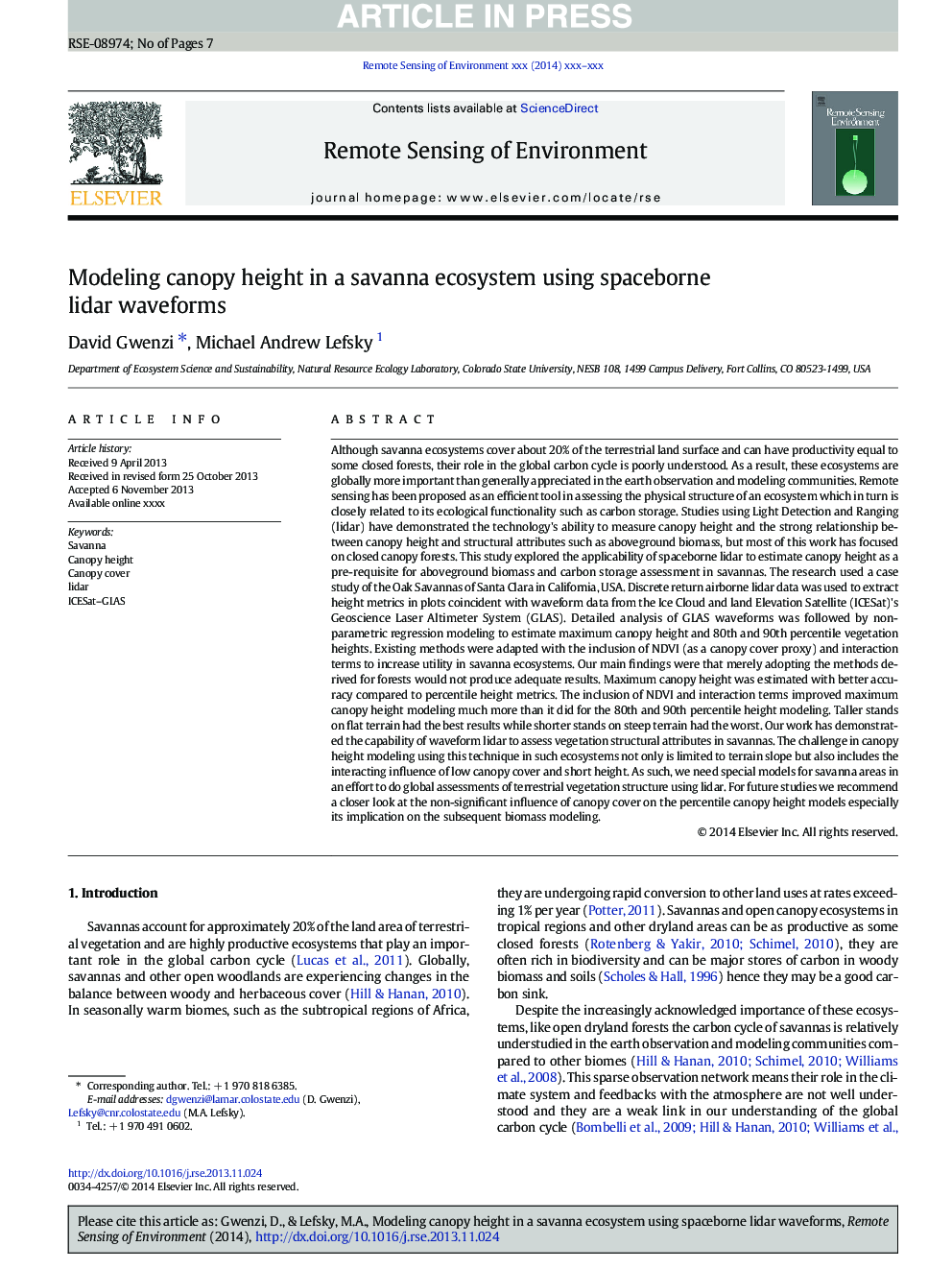| کد مقاله | کد نشریه | سال انتشار | مقاله انگلیسی | نسخه تمام متن |
|---|---|---|---|---|
| 6346453 | 1621246 | 2014 | 7 صفحه PDF | دانلود رایگان |
عنوان انگلیسی مقاله ISI
Modeling canopy height in a savanna ecosystem using spaceborne lidar waveforms
ترجمه فارسی عنوان
مدل سازی ارتفاع سایبان در یک اکوسیستم ساوانا با استفاده از شکل موج لیبر فضایی
دانلود مقاله + سفارش ترجمه
دانلود مقاله ISI انگلیسی
رایگان برای ایرانیان
کلمات کلیدی
موضوعات مرتبط
مهندسی و علوم پایه
علوم زمین و سیارات
کامپیوتر در علوم زمین
چکیده انگلیسی
Although savanna ecosystems cover about 20% of the terrestrial land surface and can have productivity equal to some closed forests, their role in the global carbon cycle is poorly understood. As a result, these ecosystems are globally more important than generally appreciated in the earth observation and modeling communities. Remote sensing has been proposed as an efficient tool in assessing the physical structure of an ecosystem which in turn is closely related to its ecological functionality such as carbon storage. Studies using Light Detection and Ranging (lidar) have demonstrated the technology's ability to measure canopy height and the strong relationship between canopy height and structural attributes such as aboveground biomass, but most of this work has focused on closed canopy forests. This study explored the applicability of spaceborne lidar to estimate canopy height as a pre-requisite for aboveground biomass and carbon storage assessment in savannas. The research used a case study of the Oak Savannas of Santa Clara in California, USA. Discrete return airborne lidar data was used to extract height metrics in plots coincident with waveform data from the Ice Cloud and land Elevation Satellite (ICESat)'s Geoscience Laser Altimeter System (GLAS). Detailed analysis of GLAS waveforms was followed by non-parametric regression modeling to estimate maximum canopy height and 80th and 90th percentile vegetation heights. Existing methods were adapted with the inclusion of NDVI (as a canopy cover proxy) and interaction terms to increase utility in savanna ecosystems. Our main findings were that merely adopting the methods derived for forests would not produce adequate results. Maximum canopy height was estimated with better accuracy compared to percentile height metrics. The inclusion of NDVI and interaction terms improved maximum canopy height modeling much more than it did for the 80th and 90th percentile height modeling. Taller stands on flat terrain had the best results while shorter stands on steep terrain had the worst. Our work has demonstrated the capability of waveform lidar to assess vegetation structural attributes in savannas. The challenge in canopy height modeling using this technique in such ecosystems not only is limited to terrain slope but also includes the interacting influence of low canopy cover and short height. As such, we need special models for savanna areas in an effort to do global assessments of terrestrial vegetation structure using lidar. For future studies we recommend a closer look at the non-significant influence of canopy cover on the percentile canopy height models especially its implication on the subsequent biomass modeling.
ناشر
Database: Elsevier - ScienceDirect (ساینس دایرکت)
Journal: Remote Sensing of Environment - Volume 154, November 2014, Pages 338-344
Journal: Remote Sensing of Environment - Volume 154, November 2014, Pages 338-344
نویسندگان
David Gwenzi, Michael Andrew Lefsky,
